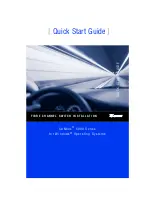
1. Functional Overview > Multicast Engine
27
Tsi578 User Manual
June 6, 2016
Integrated Device Technology
www.idt.com
The packet transmitter and the packet receiver cooperate to ensure that packets are never dropped
(lost). A transmitter must retain a packet in its buffers until the port receives a packet accepted control
symbol from the other end of the link.
1.2.3
Maintenance Requests
A maintenance packet is the only packet type that will be modified by the switch. If the hop count
value of the maintenance request is 0, the maintenance request is forwarded to the register bus for
processing. The register bus accesses the registers in the appropriate port. The response to the
maintenance request is compiled into a maintenance response packet and queued by the port for
transmission. Maintenance packets with a non-zero hop count value have their hop count decremented,
CRC recomputed, and are then forwarded to the port selected by the destination ID value in the look up
table.
1.2.4
Control Symbols
Control symbols received by the Tsi578 have their CRC validated, and their field values checked. If
either the CRC is incorrect or the control symbol field values are incorrect, a packet-not-accepted
control symbol is sent back and the control symbol is discarded. Otherwise, the control symbol is used
by the port for purposes of packet management in the transmit port or link maintenance.
1.3
Multicast Engine
The Tsi578 multicast functionality is compliant to the
RapidIO Version 1.3 Part 11 Multicast
Specification
.
1.3.1
Multicast Operation
In a multicast operation, packets are received at the speed of any ingress port (up to 10 Gbits/s) and
broadcast at the speed of the egress ports (up to 10 Gbits/s for a 4x mode port operating at
3.125 Gbits/s) to multiple ports capable of accepting packets for transmission. The maximum amount
of data that can be transmitted by the switch is 70 Gbits/s for seven egress ports operating at maximum
width of 4x and a lane speed of of 3.125 Gbit/s, based on the the number of ports on the Tsi578.
Packets are routed to the multicast engine based on their destinationID and Transaction Type (TT) field
value. If no match is found for the destinationID and TT field, then the ingress lookup tables are used to
route the packet. A maximum of eight different DestID/TT field combinations can be routed to the
multicast engine. Each destinationID/TT set can be multicast to a different set of egress ports. A set of
egress ports that packets are multicast to is called a multicast group and is represented by the multicast
mask in the group table. A multicast packet is never sent out on the port that it was received on. Any
number of ports can share the same multicast group.
Multicast packets are accepted by egress ports based on priority. In the event that multicast and unicast
traffic are competing for resources in the egress port, multicast specific egress arbitration can be used
to favour multicast or unicast traffic. This allows a group of endpoints that need to multicast to each
other to share the same multicast mask.
















































